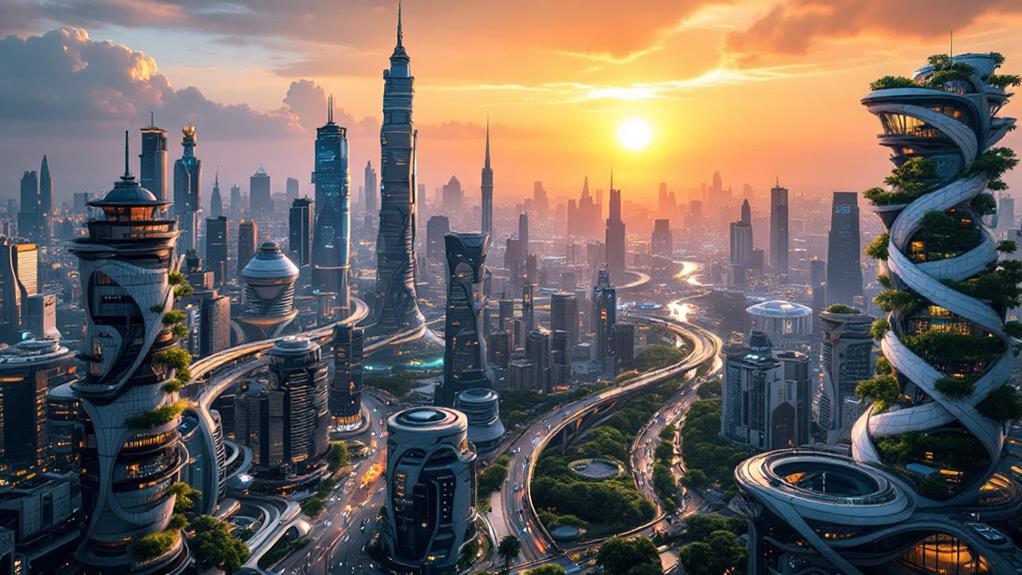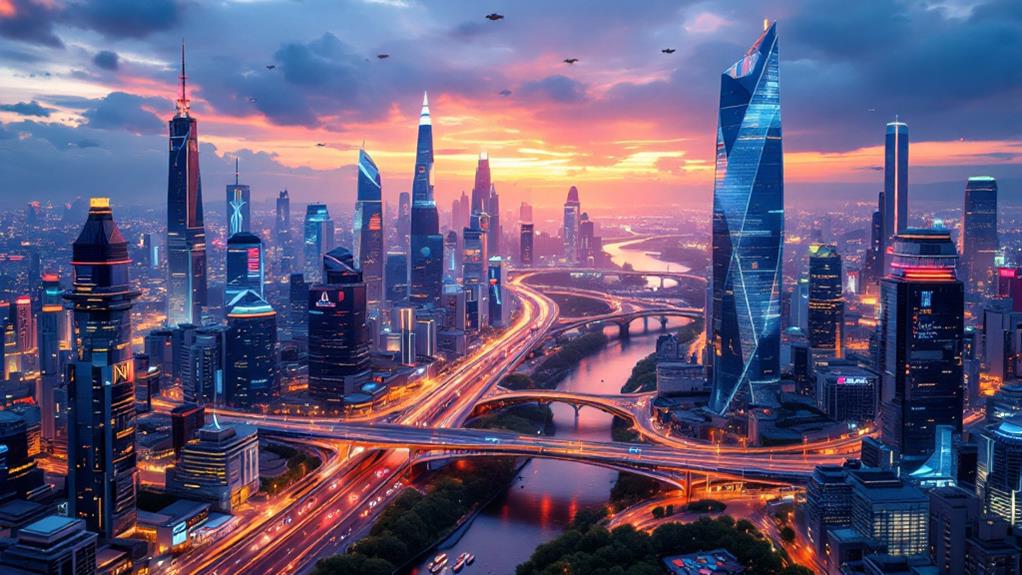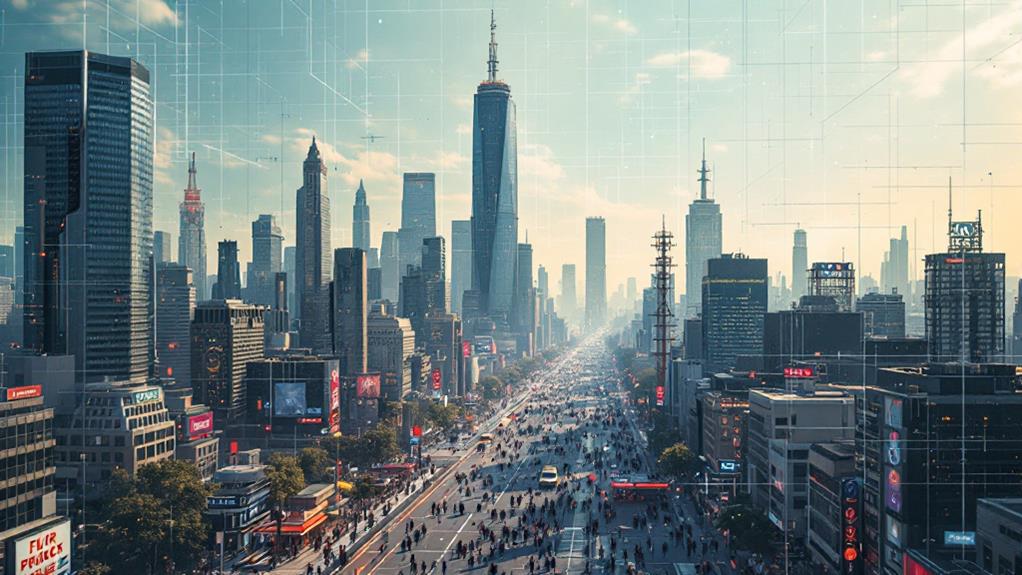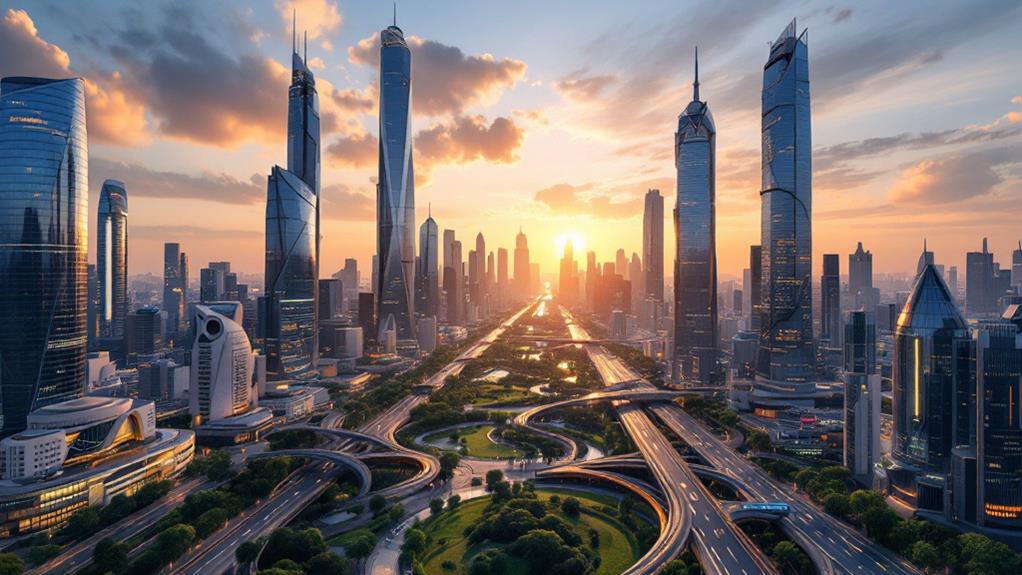Future Megacities: Predicting the Next Largest Urban Centers by 2050

By 2050, the urban landscape is set to transform with the emergence of new megacities. Expect African cities, particularly Lagos and cities in Nigeria, to see explosive growth due to natural population increases. South Asian cities like Delhi, which could become the largest megacity with nearly 50 million people, will substantially expand. Economic hubs such as Manila and Bangalore will attract a vast influx of migrants, enhancing their urban populations. While Tokyo faces a decline due to aging demographics, the need for groundbreaking urban planning and sustainable development will be vital. There's much more to uncover about these dynamic urban shifts.
Factors Driving Urban Growth
When you look at the future of megacities, it's clear that several factors are driving urban growth. One of the most significant is urbanization, fueled by both push and pull factors. People are fleeing violence and ecological degradation in rural areas, seeking better living standards and economic opportunities in cities. This migration is a major force behind the swelling populations of megacities.
Africa stands out as a key region in this urban transformation. With its population growth projected to be among the highest, the continent is set to witness a dramatic rise in urban residents. For instance, Nigeria alone is expected to add 189 million urban dwellers by 2050. This surge underscores the critical role Africa plays in the global urbanization narrative as its cities expand rapidly.
Moreover, the pursuit of economic opportunities is another driver of urban growth. Many individuals flock to cities like Manila and Bangalore, where economic prospects are brighter. These cities are projected to experience a 150% GDP growth by the end of the decade, illustrating the strong link between urbanization and economic development. As these trends unfold, megacities will continue to evolve and reshape global demographics.
Current Megacity Landscape
As urban growth accelerates, the current megacity landscape offers a snapshot of our rapidly urbanizing world. Today, there are 33 recognized megacities, each housing over 10 million people. Tokyo stands as the most populous, with 37.3 million residents, showcasing an impressive urban sprawl. You might be surprised to learn that India's Delhi follows closely with a population of 32.3 million, highlighting India's significant role in the megacity scene. Meanwhile, Shanghai, with its lively streets and colorful culture, hosts 28.7 million people.
The megacities are not just growing; they're evolving. By 2050, the number of megacities is projected to increase to 67, implying a substantial population growth of 266 million. Significantly, India is set to witness Delhi's transformation into the largest megacity, with nearly 47 million inhabitants. This growth trajectory underscores the dynamic urban expansion in Asia, which you can expect to continue.
While some megacities thrive, others face decline. Established centers like Tokyo, Osaka, and Moscow are projected to see population decreases due to aging populations and lower fertility rates. This shift emphasizes the changing demographic patterns within urban landscapes.
Economic Impacts of Megacities

Megacities are not just lively centers of population; they're also powerhouses of economic activity. As urbanization accelerates, these cities are set to become even more vital to global economic growth. By 2050, megacities like Manila and Bangalore are projected to see a 150% increase in GDP, highlighting their critical role as economic hubs. You'll find that these urban giants attract immense investment and talent, propelling them to account for a significant portion of global GDP growth.
Urbanization in megacities is intrinsically linked to job creation. The concentration of industries and services in these areas drives economic development, and as the population of megacities rises by 266 million by 2050, their significance in global economic networks will only intensify. However, disparities in economic growth rates across regions underscore the need for targeted infrastructure development to sustain progress.
Consider these key factors:
- Economic Output: Significant increases in GDP are expected.
- Investment & Talent Attraction: Megacities draw significant global interest.
- Job Creation: Urbanization enhances employment opportunities.
- Infrastructure Needs: Fundamental for maintaining economic momentum.
Demographic Shifts in Urban Areas
By 2050, urban areas worldwide will undergo significant demographic shifts that are set to redefine city landscapes. These changes will be most pronounced in Africa, where cities are projected to experience the highest population growth rates. This surge in urban population will considerably influence global demographics, positioning cities like Lagos, Nigeria, as essential players among megacities worldwide. Nigeria's youthful demographic will be a driving force behind its urban growth, contrasting sharply with the aging populations seen in megacities of developed nations like Tokyo.
In South Asia, the trend of urban migration will propel cities like Delhi to become the largest megacities globally, with a population nearing 47 million residents. This projected growth reflects a broader shift where urban centers in developing regions expand rapidly due to younger populations and migration patterns. Meanwhile, megacities in developed countries face demographic challenges due to low birth rates and aging populations, leading to potential declines in resident numbers.
Net migration will play a vital role in sustaining the population of older megacities. These cities will attract younger individuals seeking economic opportunities, balancing the demographic shifts and maintaining their status as thriving urban centers.
Challenges in Predicting Growth

Predicting the growth of future megacities is a complex task, as varying statistics and projections often lead to discrepancies in expected population figures. You'll find that different sources present conflicting forecasts, making it challenging to pinpoint which cities will become the next urban giants by 2050. The dynamic nature of urbanization, deeply intertwined with migration and demographic dynamics, adds layers of complexity to these predictions. For instance, the United Nations revised its timeline for India surpassing China in population, demonstrating just how fluid demographic forecasts can be.
To navigate these challenges, consider:
- Continuous Monitoring: Regularly update data on urbanization trends to reflect changes accurately.
- Migration Patterns: Analyze shifts in migration, as they can dramatically alter population projections.
- Economic and Political Factors: Understand how these can accelerate or decelerate city growth.
- Aging Populations: Factor in demographic dynamics, like aging, which can affect labor markets and growth.
Cities like Kuala Lumpur and Wuhan may reach megacity status by 2035, but this can shift due to unforeseen factors. Keeping an eye on these elements is vital for accurate forecasting, helping you anticipate future urban landscapes more effectively.
Regional Megacity Projections
Urban landscapes are set to undergo a transformative shift by 2050, with the number of megacities increasing to 67 globally. This surge is driven by significant urban population growth, with regions like Africa and the emerging Asia Pacific at the forefront. You're looking at African cities experiencing the fastest growth due to naturally high population increases. These cities will become key players in the megacity dynamics, transforming not just the continent but the global urban scene.
In the emerging Asia Pacific, cities like Manila and Bangalore are projected to remain giants in the urban landscape. They're not just expanding regarding population; their economies will also see remarkable GDP growth. As you investigate these regions, you'll find that urban migration and younger demographic profiles are crucial factors fueling this population growth. Delhi is poised to lead as the largest megacity, with its population nearing 49.6 million by 2050, showcasing the massive urban shift toward these regions.
Urban Planning and Policy Needs

Steering through the complexities of urban planning for 2050 requires foresight and innovation. With 2.5 billion more people expected to inhabit cities, especially in rapidly expanding megacities across Africa and Asia, infrastructure development becomes vital. You must develop thorough policy frameworks to tackle housing, transportation, and fundamental services as these urban centers grow. Megacities will multiply, with projections estimating 67 globally, demanding that you address the needs of diverse populations. The challenge lies in balancing the youthful demographics of African cities with the aging populations of places like Tokyo.
To effectively manage urban growth, consider these strategic focuses:
- Equitable Resource Allocation: Guarantee fair distribution of resources and services, especially in countries like India, China, and Nigeria, which will drive a significant portion of global urban growth.
- Diverse Demographic Planning: Tailor strategies to accommodate both young and aging populations in different regions.
- Sustainable Development Integration: Incorporate practices that address environmental and social challenges, guaranteeing livable conditions for all.
- Innovative Infrastructure Solutions: Develop infrastructure that is resilient and adaptable to future demands.
Sustainable Strategies for Future Cities
Envisioning the future of urban landscapes, sustainable strategies become essential as cities prepare to welcome 2.5 billion more inhabitants by 2050. You've got to think about how sustainable urbanization can transform these growing megacities into livable spaces. The key lies in enhancing infrastructure and public services. You can't overlook integrated policies that focus on housing, transportation, and energy. These policies must guarantee inclusivity for vulnerable groups, making certain no one gets left behind in this urban surge.
Investment in sustainable infrastructure development is critical. With rapid urbanization concentrated in regions like Africa and Asia, you need solutions that address environmental and social challenges. Strengthening connections between urban and rural areas can greatly enhance development outcomes, providing better resource access and improving living conditions.
Adopting groundbreaking technologies is a game-changer. By implementing energy-efficient systems and renewable energy sources, you create resilient urban environments capable of supporting diverse populations. These technologies not only reduce the carbon footprint but also pave the way for sustainable growth. So, as you think about the future of cities, keep in mind that sustainable strategies are the backbone of urban development, guaranteeing thriving, inclusive societies by 2050.



